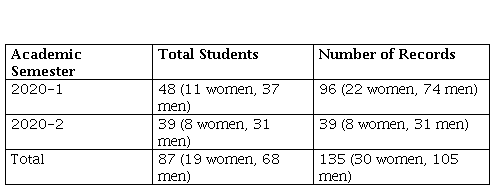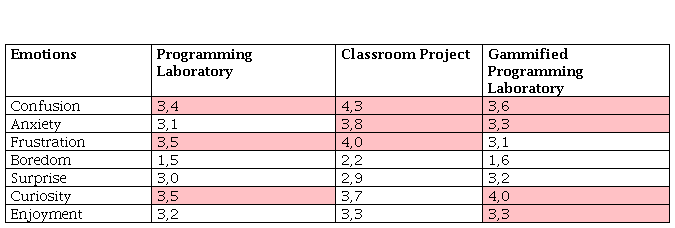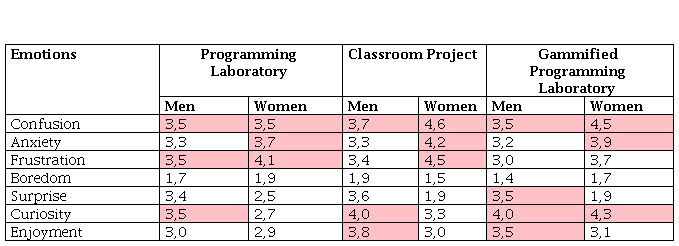I. Introduction
Introductory programming courses are incorporated into the curricula of computer science and related careers, since these professions appeared in the offerings of universities. These courses are considered highly relevant, since they provide the student with a foundation in training and guarantee professional practice in programming tasks [1]. The relevance of this course in the curricula becomes evident, when evaluating the amount of research related to the teaching of programming, and that it has been approached from different disciplines [2, 3, 4].
This identified relevance of the programming courses and their impact on the continuity of students in said careers has motivated an important number of investigations, such as [5, 6, 7], that seek to identify the factors that influence the success or failure of students in programming courses at university level. One of the reasons identified as causing the low levels of approval in programming courses is the complexity in their content, which requires students to have strong skills of abstraction and logic, that in many occasions have not been developed in the previous school time [6]. The methodologies and activities implemented for teaching programming are also considered factors that affect the success or failure of these courses [2].
The level of motivation is not often identified as an element that affects the success or failure of a student, however, some studies have shown that a motivated student will find the necessary mechanisms to complete his programming course successfully [7]. A motivated student with a positive emotional experience influences directly the continuity of these programs [10-11].
The emotions that students experience are identified as a relevant element in the learning of programming, but they are an aspect that has not been widely addressed among the factors that influence the success of this type of course [12-13]. There is a limited number of studies that address the emotional response of students when they learn to program [14, 15, 16, 17]. Out of a group of 29 studies analyzed, only one of them [14] addressed the problem from a gender perspective, therefore, it can be said that this variable is an aspect little considered in the different works presented in the literature.
In many publications, emotions are identified as a key element in the decision to continue with computer and related programs [15]. This emotional experience is also considered and becomes more relevant when analyzing the participation of women in the careers above [20-21]. The female gender is considered to have a low participation in the computer and related sectors because of the great challenges it generates [18].
The research questions formulated in this paper are similar to some research questions proposed in another study5 but in this paper we contextualize them in a Colombian university:
What emotions are most frequently detected in students of computer-related careers, while learning to program?
What are the characteristics of the learning activities that generate the most positive emotions, and which generate negative ones?
What differences are there in the emotions reported by women and men while performing different programming learning activities?
The structure of this document is organized in the following way: in this section, the theoretical elements taken into account for the study are presented; section II, succinctly presents the method used. Then, in section III the results are presented and analyzed to end with a discussion of the study in section IV.
A. Emotions
An emotion is defined as a short and intense episode in response to a particular reference[19]. An emotion is perceived in each person in a specific way and is subjective[20]. An emotion is additionally associated with other physical changes in people.
When emotions originate in academic environments they are known as academic emotions. Pekrun [20] classifies these emotions into four groups: (1) social emotions generated from the teacher-student relationship and group learning, such as sympathy or envy; (2) thematic emotions associated with different course topics; (3) achievement emotions related to activities that lead to success or failure, such as embarrassment when unable to do an activity, or commitment when learning is achieved; and (4) epistemic emotions generated by cognitive processes, such as surprise towards a new concept or confusion and frustration caused by difficulties.
Epistemic emotions" are a subset of the academic ones that are perceived, in the performance of tasks that generate cognitive processes [21], these emotions are: surprise, curiosity, excitement, confusion, anxiety, frustration and boredom. For this study, epistemic emotions have been chosen, as they are closely related to student learning [22].
B. Programming Learning Activities
Learning activities are those that take place in a classroom to guide the different topics of a course. Activities such as programming laboratories, classroom projects, exams, master classes, among others, are carried out in learning processes. Some of these activities have been designed with innovative components that seek to improve student motivation, such as play elements [23] and collaborative elements, in educational contexts that evidence positive results for the student. Throughout the research, it was determined through surveys that teachers who teach the introductory programming courses perform similar activities, in order to encourage student learning [24].
For the teaching of programming, activities such as programming labs, classroom projects, quizzes, exams, and master classes are included, some of them with variations related to gamma and/or collaboration elements incorporated [25]. Teachers agree that they face the challenge of keeping students focused and motivated, because they lose attention earlier and earlier in each class. This has led them to think of new, more innovative activities.
C. Learning About Programming
When a student makes the decision to study computer science, computing or similar careers, the motivation varies according to the difficulties he or she faces and he or she manages to solve [26]. Some researchers have investigated how moods and motivation affect the learning process of programming. Some authors argue that behaviors and moods influence programming learning [32-33]. When students experience failures, they trigger a multitude of reactions, which affect their emotional state in a negative way [2, 33].
Programming is a highly cognitive activity that requires students to develop skills [4], and high level cognitive processes [34-35]. Because of this, epistemic emotions are the ones that have the greatest impact on programming learning. This is demonstrated by studies in this area that identify confusion, frustration, boredom, and excitement as the most prevalent emotions [15, 36, 37, 38].
D. Gender
The gender gap in computer science careers generates concern in the industrial, social and academic fields. It is said that the participation of men in the software industry is above 85% [32]. For example, in Colombia, one out of every 40 software companies has a woman CEO, which translates into 2.5% in this type of role. Many factors related to the gender gap have been investigated, including the lack of female role models, differences in previous programming experience, hostile culture, and dropout rates [40-41]. Authors have argued that cultural aspects, such as the often competitive nature of assessment in computer classes, the encouragement of an obsessive and socially isolated approach to performing work, and the small number of female role models, make female students feel isolated, which can lead to significant attrition rates [34].
Results showed that gender difference may not come into play at all when it comes to computer programming. However, other factors such as emotions or attitudes may be responsible [35]. If programming skills are clearly very similar between men and women, studying emotions is one element that can be taken into account to promote women's success in these roles [36].
One of the reasons for gender gap is related to the affective experiences of students; it has been shown that the affective factors that influence success may differ between men and women [35].
E. Mechanisms to Identify Emotions
Different mechanisms have been identified to perceive or identify emotions [37], these mechanisms are classified from the perspective of participation of the user being evaluated or from the observation of a third party, to analyze their emotions:
Measurement of physiological reactions: This is a mechanism that involves the user as the primary source, but the information is provided by a device that yields values in relation to the emotions considered for analysis [38]. This way of measuring emotions corresponds for example to measurements from headbands to measure brain activity, devices to measure blood pressure, heart rate, among others. They are important because they give results that the user does not control, since they are captured on real physical reactions; but they are not very accepted by users because they consider them intrusive and they feel intimidated with their use.
Self-report: It is in a form, survey [21], or interview, where the user assigns values related to the emotions they experience. In the case of the form, the user describes his or her emotions on a qualitative or numerical scale, in order to have clarity not only on how the emotion is experienced, but also on how intensely it is experienced. It is the most widely used mechanism for reporting emotions [39], because it is easy to use, because users feel less invaded in their privacy, and because it is economical to implement and process the information from it.
Measurements based on observation of behaviors: It is a mechanism in which the primary source is a third party that observes the individual's emotional and behavioral reactions [39]. They include the observation of the behavior (e.g., body position), their gestures (e.g., eyebrows, lips, nose, mouth) are observed. This mechanism offers the advantage that users do not know when they are being observed.
II. Method
In this study, the Epistemically-Related Emotion Scales (EES) instrument [21] was used. This is a self-reporting instrument that involves seven epistemic emotions (boredom, anxiety, confusion, excitement, frustration, surprise, and curiosity). It was selected because it involves the set of epistemic emotions, which are the ones considered for this study when engaging in high-level cognitive processes, such as the learning processes of programming. These emotions are measured on a scale from 1 to 5, supported by a Likert scale, where 1 is selected when the emotion is not perceived and 5 when it is perceived at its highest rating.
It was decided to use the self-reporting mechanism since the aim was to identify in a simple way the emotions perceived by the students, and not to generate in them the perception of feeling invaded by external devices. Students reported the emotions right after the selected learning activity was performed. In total, 6 data collections were made for three different types of learning activities (two classroom projects, two programming laboratories, and two gamma programming laboratories), which will be explained later. The EES instrument was distributed to the students through a Google form for the programming labs, tests and programming projects.
For this research, activities of different nature were selected (Table 1) to evaluate the emotions experienced by students.
This study investigated the epistemic emotional reactions to programming tasks, from a sample of students enrolled in an introductory programming course, during the year 2020 at the University of San Buenaventura Cali-Colombia. Table 2 shows the participants in each semester, 2019-2 corresponds to the semester from July to December 2019, and 2020-1 corresponds to the semester from January to June 2020. As freshmen in computer science and related fields, the ages range from 17 to 19.
To start collecting the data, students had to fill out a first form that allowed them to point out their identification or school code, their gender, and select the category with which they identified themselves the most, out of a description of the different types of players, according to the categories established by Bartle. This without knowing they would be classified in a group.
In total, in both periods, 87 students distributed in two programming groups responded to 3 different types of learning activities (2 gamma programming laboratories, 2 classroom projects, 2 programming laboratories).
III. Results
This section presents an analysis of the data related to the epistemic emotions that students experience in the different learning activities of the programming. Table 3 presents the data obtained for each type of learning activity and the averages according to the perceived scale.
Table 4 analyzes behavior at the level of emotions, taking into account the gender variable. These emotions were reported individually in each of the learning activities reported.
Different emotions are identified between men and women, for example, emotions such as anxiety. In all the activities, women felt high levels of anxiety, but they also felt greater curiosity.
In general, it should be noted that the emotion of boredom was perceived in negative ranges (students did not feel it or felt it little). Negative emotions, mainly for women, are shown in high values (Strong and Very Strong).
IV. Conclusions and recommendations
The research questions are discussed and answered in this section:
-
What epistemic emotions are most often detected in students as they learn to program?
In general, the emotions most often perceived in the three activities in this experiment are anxiety, frustration, confusion, and curiosity. Three negative emotions, one positive one.
Confusion is an emotion that is repeated in men and women in all three activities evaluated. When analyzing the total data obtained, there are emotions that generate high values during its experimentation, this is the case of confusion. This emotion, in both men and women, presents the highest rates, with values of 4 and 5 reported by students.
-
What characteristics that generate the most positive epistemic emotions do learning activities have?
Evidently, the activity that incorporates gamified elements provokes a greater amount of positive emotions in students. Negative emotions decrease their average compared to non-gamified activities. The gamified activity improved the evaluation of the emotions of curiosity, surprise and enthusiasm. The activities involve challenges for the students since they obtain badges, additional points, and compete among them. Also, they generate moments of collaboration between the students, particularly in the cases in which the socializer students (player category) build a common solution and contribute to the achievement of the final result: their program finished and running.
The carried-out activities that generated the most negative epistemic emotions were the ones in the traditional programming laboratory. However, the classroom project caused, in the totality of female students, negative emotions, while in men it caused one negative emotion (confusion). It should be emphasized that all the activities analyzed have an associated grade for the students, which generally brings about higher levels of anxiety.
Confusion is considered a negative epistemic emotion that is perceived by men and women at the highest levels. It was perceived at higher levels in the classroom project, compared to the other two activities.
Boredom almost never presents high levels of perception, that allows us to analyze that the activities generate attention in the students’ while working in their accomplishment.
Additionally, frustration is more highly perceived in the classroom project of one of the two analyzed groups. It can be intuited that the teacher’s approach towards support can make the group feel, in general, more frustrated when answering the questions, compared to the group oriented by another teacher.
-
What differences are there in the epistemic emotions reported by women and men as they learn to program?
Some emotions are perceived differently between men and women, and are striking because the average between male and female student groups varies from one to the other. Anxiety is perceived in all the analyzed activities in greater proportion in women, with respect to the emotions perceived in men. Frustration is also higher for women in all activities compared with the results for men. The differences between the average results for male and female students are considerable, in some cases exceeding one unit of difference.
Likewise, curiosity is a highly perceived emotion, in the specific case of the gamma programming laboratory, women felt very high levels of this emotion, allowing us to assume that the elements of gamification and collaboration allow students to feel positively towards the development of programming learning.
It is important to complement the present study with the realization of other types of activities such as exams or tests, which, according to various researchers, also report as activities that generate epistemic emotions. This, in order to furtherly analyze the emotional behavior of men and women.



















